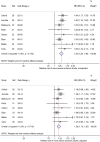Sex Differences in Severity of Stroke in the INSTRUCT Study: a Meta-Analysis of Individual Participant Data
- PMID: 30590965
- PMCID: PMC6405721
- DOI: 10.1161/JAHA.118.010235
Sex Differences in Severity of Stroke in the INSTRUCT Study: a Meta-Analysis of Individual Participant Data
Abstract
Background Women have worse outcomes after stroke than men, and this may be partly explained by stroke severity. We examined factors contributing to sex differences in severity of acute stroke assessed by the National Institutes of Health Stroke Scale. Methods and Results We pooled individual participant data with National Institutes of Health Stroke Scale assessment (N=6343) from 8 population-based stroke incidence studies (1996-2014), forming part of INSTRUCT (International Stroke Outcomes Study). Information on sociodemographics, stroke-related clinical factors, comorbidities, and pre-stroke function were obtained. Within each study, relative risk regression using log-binominal modeling was used to estimate the female:male relative risk ( RR ) of more severe stroke (National Institutes of Health Stroke Scale>7) stratified by stroke type (ischemic stroke and intracerebral hemorrhage). Study-specific unadjusted and adjusted RR s, controlling for confounding variables, were pooled using random-effects meta-analysis. National Institutes of Health Stroke Scale data were recorded in 5326 (96%) of 5570 cases with ischemic stroke and 773 (90%) of 855 participants with intracerebral hemorrhage. The pooled unadjusted female:male RR for severe ischemic stroke was 1.35 (95% CI 1.24-1.46). The sex difference in severity was attenuated after adjustment for age, pre-stroke dependency, and atrial fibrillation but remained statistically significant (pooled RR adjusted 1.20, 95% CI 1.10-1.30). There was no sex difference in severity for intracerebral hemorrhage ( RR crude 1.08, 95% CI 0.97-1.21; RR adjusted 1.08, 95% CI 0.96-1.20). Conclusions Although women presented with more severe ischemic stroke than men, much although not all of the difference was explained by pre-stroke factors. Sex differences could potentially be ameliorated by strategies to improve pre-stroke health in the elderly, the majority of whom are women. Further research on the potential biological origin of sex differences in stroke severity may also be warranted.
Keywords: epidemiology; sex difference; stroke.
Figures



References
-
- Phan HT, Blizzard CL, Reeves MJ, Thrift AG, Cadilhac D, Sturm J, Heeley E, Otahal P, Konstantinos V, Anderson C, Parmar P, Krishnamurthi R, Barker‐Collo S, Feigin V, Bejot Y, Cabral NL, Carolei A, Sacco S, Chausson N, Olindo S, Rothwell P, Silva C, Correia M, Magalhaes R, Appelros P, Korv J, Vibo R, Minelli C, Gall S. Sex differences in long‐term mortality after stroke in the INSTRUCT (INternational STRoke oUtComes sTudy): a meta‐analysis of individual participant data. Circ Cardiovasc Qual Outcomes. 2017;10:e003436. - PubMed
-
- Phan HT, Blizzard CL, Reeves MJ, Thrift AG, Cadilhac DA, Sturm J, Heeley E, Otahal P, Vemmos K, Anderson C, Parmar P, Krishnamurthi R, Barker‐Collo S, Feigin V, Bejot Y, Cabral NL, Carolei A, Sacco S, Chausson N, Olindo S, Rothwell P, Silva C, Correia M, Magalhães R, Appelros P, Kõrv J, Vibo R, Minelli C, Gall SL. Factors contributing to sex differences in functional outcomes and participation after stroke. Neurology. 2018;90:e1945–e1953. - PubMed
Publication types
MeSH terms
Grants and funding
LinkOut - more resources
Full Text Sources

